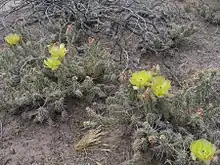| Opuntia arenaria | |
|---|---|
 | |
| Scientific classification | |
| Kingdom: | Plantae |
| Clade: | Tracheophytes |
| Clade: | Angiosperms |
| Clade: | Eudicots |
| Order: | Caryophyllales |
| Family: | Cactaceae |
| Genus: | Opuntia |
| Species: | O. arenaria |
| Binomial name | |
| Opuntia arenaria Engelmann | |
Opuntia arenaria was considered a variety of O. polyacantha by many botanists, and is still treated that way in the Flora of North America.[1] However, O. arenaria is diploid and O. polyacantha is tetraploid. It was described by Engelmann in 1856.[2]
Description
Opuntia arenaria can grow in soil that is essentially pure sand. It has rhizomes up to 1.5 m long that give rise to above ground shoots with small cladodes that are 4-7 x 2–3 cm in size. Major spines are found in the distal areoles and are often reflexed, up to 30 mm long. Minor spines are strongly deflexed and much shorter. Overall, plants (clumps) of cladodes may be 20–30 cm across and about 4–8 cm tall. Fruits are small, about 2.5 cm.
References
- ↑ "Flora of North America". Retrieved 24 June 2017.
{{cite journal}}: Cite journal requires|journal=(help) - ↑ Engelmann. "Opuntia arenaria" (PDF). Opuntia Web. Joseph Shaw. Retrieved 17 September 2018.
External links
This article is issued from Wikipedia. The text is licensed under Creative Commons - Attribution - Sharealike. Additional terms may apply for the media files.